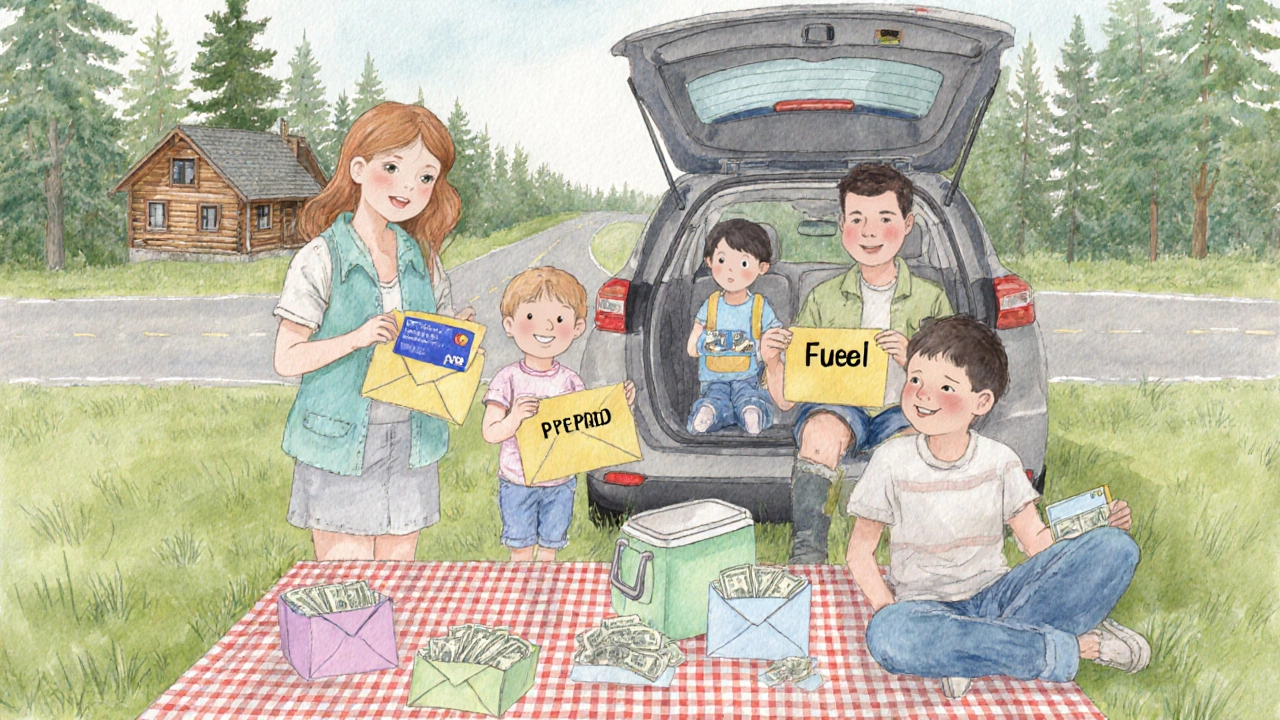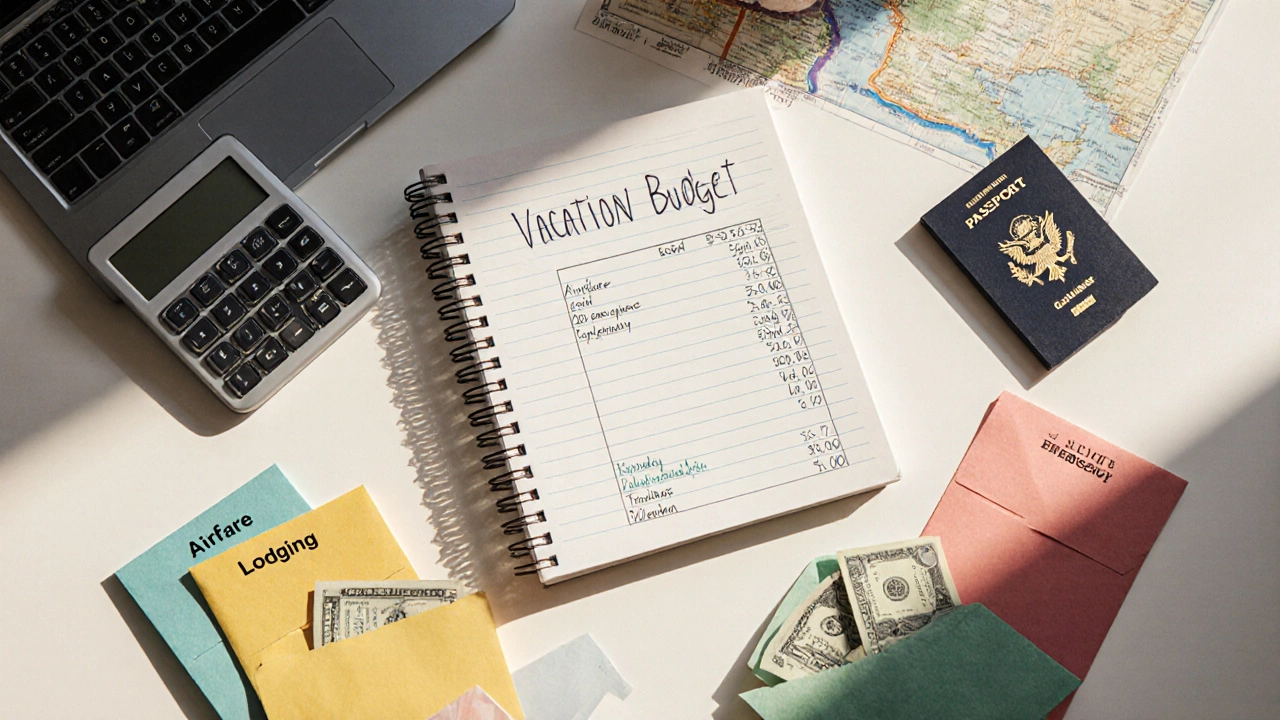Dave Ramsey Vacation Budget Planner
Your Vacation Details
Dave Ramsey's Baby Steps
Your Budget Breakdown
Vacation Tips Based on Dave Ramsey
- Use cash or prepaid travel cards to avoid credit card temptation
- Build a separate travel emergency fund (1-2% of vacation budget)
- Apply the envelope budgeting method for each category
- Postpone vacation plans if you still have consumer debt
Ever wondered if you can enjoy a getaway without blowing your budget or adding more debt? Dave Ramsey tackles that exact question in his talks, books, and radio shows. He isn’t a travel guru, but his money‑management principles can actually help you plan a vacation that feels luxurious without the financial hangover.
Key Takeaways
- Never schedule a vacation until you’ve completed the first two Baby Steps.
- Build a dedicated emergency fund for travel‑related surprises.
- Clear all consumer debt before you book a trip - the Debt Snowball is non‑negotiable.
- Use a zero‑based or envelope budgeting method to allocate every dollar for the vacation.
- Stick to cash or a prepaid travel card to avoid credit‑card temptation.
Who is Dave Ramsey?
Dave Ramsey is a U.S.‑based personal‑finance speaker, author of “The Total Money Makeover,” and host of a nationally syndicated radio show. His core message: live debt‑free, spend less than you earn, and follow a step‑by‑step plan he calls the Baby Steps. Though his advice is framed for Americans, the underlying math works everywhere - including here in Toronto.
The Baby Steps and Vacation Planning
Ramsey’s Baby Steps are a ladder of financial priorities. Steps1‑3 focus on emergency savings and debt elimination, which Ramsey insists must be completed before you consider discretionary spending like a holiday.
- Save $1,000 for a starter emergency fund.
- Pay off all credit‑card debt using the Debt Snowball.
- Save three to six months of expenses in a fully funded emergency fund.
Only after you’ve nailed these three steps does Ramsey say you can allocate money toward a vacation. Skipping them often leads to a holiday that feels great for a week but ruins your finances for months.
Building an Emergency Fund for Travel
A travel emergency fund is separate from your regular safety net. It covers things like flight cancellations, unexpected medical bills abroad, or a sudden need to extend your stay. Ramsey recommends topping this up with 1‑2% of your total vacation budget, stored in a high‑interest savings account you can access quickly.

The Debt Snowball and Vacations
Ramsey’s Debt Snowball method tells you to list debts from smallest to largest, pay extra on the smallest while making minimum payments on the rest, then roll that payment into the next debt once the first is cleared. He argues the psychological win keeps you motivated.
For vacations, this means: if you still carry a $2,000 credit‑card balance, you should postpone booking that beach resort until it’s gone. The peace of mind you gain far outweighs any “early‑bird” discount you might miss.
Creating a Vacation Budget with the Envelope System
The envelope system is a cash‑based budgeting tool Ramsey swears by. You label envelopes (or digital equivalents) for each expense category - airfare, accommodation, meals, activities, souvenirs - and put the allocated amount in each envelope. When an envelope is empty, you stop spending in that category.To make it work for a trip:
- Determine your total vacation budget after the first three Baby Steps.
- Break the budget down into categories based on your itinerary.
- Assign a dollar amount to each envelope - be realistic about meals and transport.
- Put the cash in physical envelopes or load a prepaid travel card with the same amounts.
- Track every expense against the envelope; adjust on the fly if you over‑ or under‑spend.
Step‑by‑Step: Planning a Ramsey‑Style Vacation
- Confirm Baby Steps 1‑3 are complete. Check that your emergency fund covers at least three months of essential expenses and that all consumer debt is cleared.
- Set a total vacation amount. Ramsey suggests no more than 10‑15% of your annual net income for a single trip.
- Open a dedicated savings account or a high‑yield online account for the vacation fund.
- Use the envelope system to allocate your budget. Keep the envelopes in a safe place during travel.
- Pay for flights and hotels with a debit card or prepaid card, not a credit card. This prevents hidden interest.
- Stick to the plan, and if you’re tempted to splurge, remind yourself of the debt‑free vision that got you here.
Common Pitfalls to Avoid
- Lifestyle inflation: Just because you earned a raise doesn’t mean your vacation budget should jump proportionally.
- Using credit cards for big ticket items - Ramsey warns that the temptation to pay the minimum and carry a balance can quickly undo years of progress.
- Skipping the emergency fund for “travel insurance” - a real emergency fund is more flexible and often cheaper than a generic policy.
- Over‑planning: booking every activity in advance can lock you into a higher cost. Leave room for free or low‑cost experiences.

Comparison Table: Ramsey Vacation Advice vs. Generic Travel Budgeting
| Aspect | Ramsey Method | Typical Travel Advice |
|---|---|---|
| Debt Status | All consumer debt cleared before booking | May allow debt‑financed trips |
| Emergency Savings | Separate travel emergency fund (1‑2% of budget) | Often ignored or folded into overall budget |
| Payment Method | Cash or prepaid card, no credit cards | Credit cards for points & rewards |
| Budget Allocation | Envelope system, zero‑based | Flexible, sometimes over‑estimates |
| Spending Limit | 10‑15% of annual net income per trip | Varies, often based on desire rather than income |
Real‑World Example: A Toronto Family Road Trip
Meet the Patel family: two adults, two kids, and a love for Ontario’s cottage country. They followed Ramsey’s steps:
- They had already completed Baby Steps 1‑3 by age 35.
- They set a $2,400 vacation budget - exactly 12% of their combined net income.
- They opened a high‑interest savings account and transferred $200 each month for 12 months.
- Using the envelope system, they allocated $800 for accommodation, $600 for fuel, $400 for food, $300 for activities, and $300 for souvenirs/emergency.
- They booked a cabin using a debit transfer, paid for gas with a prepaid card, and cooked most meals at the cabin to stay within the food envelope.
The result? A week‑long getaway that cost exactly what they planned, left no credit‑card balances, and even left $150 in the emergency envelope for a minor car repair. They returned refreshed, debt‑free, and ready for the next Baby Step.
Next Steps & Troubleshooting
- If you’re still carrying credit‑card debt: Pause vacation planning. Use the Debt Snowball until the smallest balance is gone.
- Can’t afford a full emergency fund? Start with a $500 buffer, then grow it to three‑month expenses before the trip.
- Travel costs are rising fast: Consider a “staycation” that uses the same envelope system but eliminates airfare and accommodation costs.
- Spending more than planned? Freeze the envelope, reassess priorities, and cut optional activities.
Frequently Asked Questions
Do I have to pay for a vacation in cash?
Ramsey suggests using cash or a prepaid travel card because it forces you to stay within the envelope limits. If you prefer a debit card, make sure it’s linked to a checking account without an overdraft facility.
Can I use travel rewards points if I’m debt‑free?
Only if you can repay the balance in full each month. Ramsey’s core rule is to avoid interest at all costs; points are fine, but never at the expense of paying interest.
What if an emergency happens after I’ve spent all my travel envelopes?
That’s exactly why Ramsey recommends a separate travel emergency fund. It should cover unexpected medical bills, car repairs, or a sudden need to extend your stay. If it’s depleted, you’ll need to pause travel and rebuild it before the next trip.
Is the 10‑15% of annual income rule flexible?
It’s a guideline to keep travel spending proportional to earnings. If you have a higher savings rate or extra windfalls, you can allocate a bit more, but always stay within a range that won’t jeopardize your long‑term financial goals.
How do I adjust the envelope amounts while on the road?
If you overspend in one category, move money from another envelope that has a surplus. Just keep the total budget unchanged and avoid borrowing or adding credit‑card charges.
